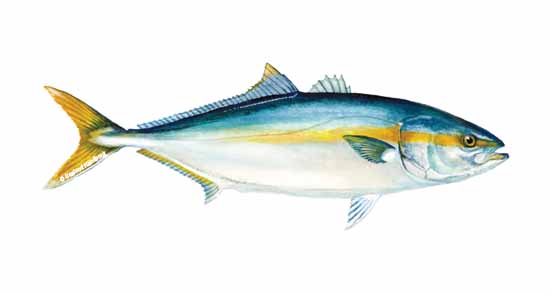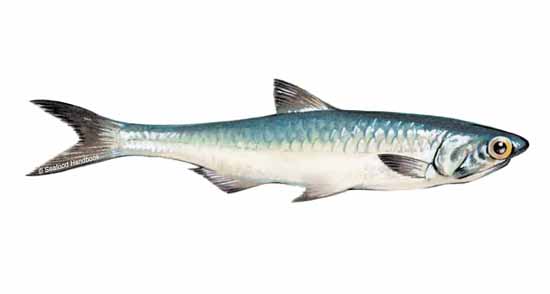By Sushi Modern | March 26th, 2018
Salmon, tuna, snapper, flounder, escolar, sea bass—there are countless fish to try as sushi and sashimi! But with a wide diversity of options comes the burden of remembering which can and cannot be safely consumed raw. Unfortunately, fish used for sushi can be susceptible to parasites like Anisakis and tapeworms that cause serious illness. That's why we've put together a helpful buying guide to flag species that have parasite risks and other hazards. When shopping for fish for sushi, use this safe sushi-grade guide and avoid any fish labeled with parasite risk (unless it was specifically frozen to be used in sushi). For a thorough report on parasites in sushi, read more about the sushi-grade myth.
Jump to:
- Fin Fish
- Shellfish
- Roe and Liver
Fish
| Name | Risks | |
|---|---|---|
| Tuna, all species (Maguro) | No risk |  |
| Yellowtail (Hamachi) | No risk |  |
| Wild Salmon (Samon) | Parasites |  |
| Farmed Salmon (Samon) | No Risk [1] |  |
| Arctic Char (Hokkyoku Iwana) | No risk |  |
| Mackerel (Saba) | Parasites |  |
| Sea Bream (Tai) | No risk |  |
| Red Snapper (Hamadai) | No risk |  |
| Porgy (Kurodai) | No risk |  |
| Eels (Unagi, Anago, and Hamo) | No risk |  |
| Flounder, wild & farmed (Hirame) | Parasites |  |
| Dover Sole (sh*tabirame) | Parasites |  |
| Wild Turbot (Makogarei) | Parasites |  |
| Farmed Turbot (Makogarei) | No risk |  |
| Gizzard Shad (Kohada) | No risk |  |
| Anchovy (Katakuchiiwashi) | No risk |  |
| Tilefish (Amadai) | No risk |  |
| Branzino (Hata) | Parasites |  |
| Barracuda (Kamasu) | No risk |  |
| Bluefish (Amikiri) | No risk |  |
| Opah (Mandai) | No risk |  |
| Dory (Matoudai) | No risk |  |
| Mahi-Mahi (Shiira) | No risk |  |
| Pompano (Koban-aji) | No risk |  |
| Smelt (Wakasagi) | No risk |  |
| Sturgeon (Shirochozame) | No risk |  |
| Tilapia (Izumidai) | No risk |  |
| Wahoo (Ono) | No risk |  |
| Escolar | Side effects [2] |  |
| Monkfish (Anko) | Parasites |  |
| Cobia (Sugi) | Parasites |  |
| Mullet (Bora) | Parasites |  |
| Hake (Heiku) | Parasites |  |
| Haddock (Montsukidara) | Parasites |  |
| Herring (Nishin) | Parasites |  |
| Sardine (Iwashi) | Parasites |  |
| Rainbow Trout (Nijimasu) | Parasites |  |
| Cod (Tara) | Parasites |  |
| Black Sea Bass (Hata) | Parasites |  |
| Chilean Sea Bass (Ookuchi) | Parasites |  |
Shellfish
| Name | Risks | |
|---|---|---|
| Shrimp, all species (Ebi) | No risk |  |
| Sea Urchin (Uni) | No risk |  |
| Octopus (Tako) | Parasites |  |
| Squid (Ika) | Parasites |  |
| Cuttlefish (Ko-ika) | No risk |  |
| Scallop (Hotate) | No risk |  |
| Abalone (Awabi) | No risk |  |
| King Crab (Tarabagani) | No risk |  |
| Blue Crab (Gazami) | No risk |  |
| Stone Crab (Kani) | No risk |  |
| Spanner Crab (Kani) | No risk |  |
| Snow Crab (Zuwaigani) | No risk |  |
| Dungeness Crab (Danjinesukani) | No risk |  |
| Peekytoe Crab (Kani) | No risk |  |
| Lobster (Ise ebi) | No risk |  |
| Langostines | No risk |  |
| Raw Geoduck (Mirugai) | No risk |  |
| Surf Clam (Nimaigai) | No risk |  |
| Manila Clam (Nimaigai) | No risk |  |
| co*ckle (Torigai) | No risk |  |
| Oyster (Kaki) | No risk |  |
| Mussels (Murasakiigai) | No risk |  |
Other
| Name | Risks | |
|---|---|---|
| Monkfish Liver (Ankimo) | Parasites [3] |  |
| Sturgeon Roe (Caviar) | No risk | |
| Salmon Roe (Ikura) | No risk | |
| Flying Fish Roe (Tobiko) | No risk | |
| Capelin Roe (Masago) | No risk |
Notes
- Farmed salmon are significantly lower risk for parasites because their feed is often parasite-free pellets. A survey of studies on parasite infection in salmon found 0% parasite infection in any samples of farmed salmon, but anywhere from 65-100% of wild salmon samples.
- Escolar can cause gastric distress after consuming even a normal-sized portion.
- Ankimo (monkfish liver) is usually cooked, eliminating the risk of parasites.
Missing a fish you'd like to see on this list? Email faq@sushimodern.com.
References
- FDA Species-Related Hazards, FDA
- Anisakidosis: Perils of the Deep, Clinical Infectious Diseases
- Seafood Handbook, SeafoodSource
Related

Get Sushi in Your Inbox!
Subscribe for the bi-monthly newsletter on sushi recipes, tutorials, and news.





